Hydrocarbon Accumulation and Overpressure Evolution of the Ordovician Carbonate Reservoirs in the Tahe Area, Tarim Basin, NW China
Abstract
:1. Introduction
2. Geological Setting
3. Samples and Methods
3.1. Samples Data
3.2. Fluid Inclusions Analysis
3.3. Measurement of Gas–Liquid Ratio
4. Results
4.1. Cathodoluminescence of Calcite Veins
4.2. Fluid Inclusion Petrography and Fluorescence
4.3. Oil Inclusion Microthermometry
4.4. Gas–Liquid Ratio of Oil Inclusion
4.5. Paleo-Pressure Recovery
4.6. Burial and Thermal History Modeling
5. Discussion
5.1. Hydrocarbon Accumulation Time
5.2. Overpressure Evolution in Carbonate Reservoirs
6. Conclusions
Author Contributions
Funding
Data Availability Statement
Conflicts of Interest
References
- Qiu, N.S.; Liu, Y.F.; Liu, W.; Jia, J.K. Quantitative reconstruction of formation paleo-pressure in sedimentary basins and case studies. Sci. Sin. Terrae 2020, 50, 793–806. [Google Scholar]
- Han, P.Y.; Ding, W.L.; Yang, D.B.; Deng, G.X.; Wang, Z.; Ma, H.L.; Lv, J.; Geng, T. Characteristics and main controlling factors of fracture development in the Ordovician carbonate reservoir, Tahe Oilfield. Earth Sci. Front. 2024, 31, 209–226. [Google Scholar]
- Li, Y.; Jin, Q.; Zhong, J.H.; Zhou, S.Z. Karst zonings and fracture-cave structure characteristics of Ordovician reservoirs in Tahe Oilfield, Tarim Basin. Acta Pet. Sin. 2016, 37, 289–298. [Google Scholar]
- Yue, Y.; Tian, J.C.; Huang, C.Y. Formation Mechanism of the Paleocene Basal Conglomerate, Southwest Tarim Basin. J. Earth Sci. 2024, 35, 1513–1526. [Google Scholar] [CrossRef]
- Chen, H.H.; Li, C.Q.; Zhang, X.M.; Chen, H.C.; Lin, Z.M. Determining the reservoir formation stages and main reservoir formation period of the Tahe Oilfield using fluid inclusions. Earth Sci. Front. 2003, 10, 190. [Google Scholar]
- Shi, W.J.; Jiang, H.; Xi, B.B. Application of the PVTX simulation of reservoir fluid inclusions to estimate petroleum charge stages: A case study in the Tuoputai area of Tarim Basin. Geol. J. China Univ. 2012, 18, 125–132. [Google Scholar]
- Chen, H.H.; Wu, Y.; Feng, Y.; Lu, Z.Y.; Hu, S.Z.; Yun, L.; Qi, L.X. Timing and chronology of hydrocarbon charging in the Ordovician of the Tahe Oilfield, Tarim Basin, NW China. Oil Gas Geol. 2014, 35, 806–819. [Google Scholar]
- Zhao, Y.Q.; Yun, L.; Wang, B.; Geng, F.; Li, H.Y.; Gu, Y.; Liu, Y.L. Main constraints and dynamic process of Ordovician hydrocarbon accumulation, central and western Tahe oil field, Tarim Basin. Pet. Exp. Geol. 2021, 43, 758–766. [Google Scholar]
- Chen, J.X.; Wang, B.; Guo, X.W.; Cao, Z.C.; Liu, Y.L.; Geng, F.; Zhang, X.Y.; Xu, H.; Zhao, J.X. Application of laser in-situ U-Pb dating of calcite to determination of the absolute time of hydrocarbon accumulation in polycyclic superimposed basins: A case study on Tahe Oilfield, Tarim Basin. Oil Gas Geol. 2021, 42, 1365–1375. [Google Scholar]
- Aplin, C.; Macleod, L.S.; Larter, S.R.; Pedersen, K.S.; Sorensen, H.; Booth, T. Combined use of Confocal Laser Microscopy and PVT simulation for estimating the composition and physical properties of petroleum in fluid inclusions. Mar. Pet. Geol. 1999, 16, 97–110. [Google Scholar] [CrossRef]
- Ping, H.W.; Chen, H.H.; Song, G.Q.; Thiéry, R. Individual oil inclusion composition prediction and its application in oil and gas accumulation studies. Earth Sci. 2012, 37, 815–824. [Google Scholar]
- Ping, H.W.; Thiéry, R.; Chen, H.H.; Liu, H.L. New methods to reconstruct paleo-oil and gas compositions and P-T trapping conditions of hydrocarbon fluid inclusions in sedimentary basins. Mar. Pet. Geol. 2023, 155, 106403. [Google Scholar] [CrossRef]
- Chen, X.; Liu, W.H.; Bao, D.; Zhang, L.P.; Chen, L.X.; Yang, M.; Zhang, J.; Li, Y.J.; Li, G.Y.; Jia, Y.F. Ordovician Palaeokarst caves in the Tahe Oilfield: Burial age of cave fills and its implications for hydrocarbon reservoirs. Earth Sci. Front. 2023, 30, 65–75. [Google Scholar]
- Lei, C.; Chen, H.H.; Su, A.; Han, S.M. Characteristics and preservation mechanism of the Ordovician deep burial karst caves in Tahe Area. Lithol. Reserv. 2014, 26, 27–31. [Google Scholar]
- Lu, X.B.; Cai, Z.Y. A study of the paleo-cavern system in fractured-vuggy carbonate reservoirs and oil/gas development-taking the reservoirs in Tahe Oilfield as an example. Oil Gas Geol. 2010, 31, 22–27. [Google Scholar]
- Qi, L.X.; Yun, L. Development characteristics and main controlling factors of the Ordovician carbonate karst in Tahe Oilfield. Oil Gas Geol. 2010, 31, 1–12. [Google Scholar]
- Zhang, Y.; Zhao, L.; Li, C.H.; Zhang, X.Z. Research Progress of paleokarst oil and gas reservoirs. Carsol. Sin. 2022, 41, 808–824. [Google Scholar]
- Cao, H.; Gong, J.J.; Wang, G.F. The cause of overpressure and its relationship with reservoir forming. Nat. Gas Geosci. 2006, 17, 422–425. [Google Scholar]
- Yang, T.Z.; Liu, C.L.; Tian, J.X.; Li, P.; Ran, Y.; Feng, D.H.; Li, G.X.; Wu, Y.P. Prediction and genesis of formation pressure in Dafengshan uplift, Qaidam Bain. Lithol. Reserv. 2023, 35, 96–107. [Google Scholar]
- Zhang, K. The discovery of Tahe Oilfield and its geologic implication. Oil Gas Geol. 1999, 20, 120–124, 132. [Google Scholar]
- Zhang, C.J.; Lv, Y.P.; Zhang, Z.Z. Features of middle-lower Ordovician Paleo-karst caves in the western slope area, Tahe oil field, Tarim Basin. Pet. Exp. Geol. 2022, 44, 1008–1017. [Google Scholar]
- Xu, H.; Guo, X.W.; Cao, Z.C.; Wang, B.; Liu, Y.L.; Chen, J.X.; Zhang, X.Y.; Luo, T. Application of minimum homogenization temperatures of aqueous inclusions in calcite veins to determine time of hydrocarbon accumulation in Ordovician of the Tahe Oilfield: Evidence from In-Situ calcite U-Pb dating by laser ablation. Earth Sci. 2021, 46, 3535–3548. [Google Scholar]
- Yun, L.; Zhai, X.X. Discussion on characteristics of the Cambrian reservoirs and hydrocarbon accumulation in Well Tashen-1, Tarim Basin. Oil Gas Geol. 2008, 29, 726–732. [Google Scholar]
- Li, Y.Q.; Sun, J.F.; Wei, H.H.; Song, S.H. Architectural features of fault-controlled karst reservoirs in the Tahe Oilfield. J. Pet. Sci. Eng. 2019, 181, 106208. [Google Scholar] [CrossRef]
- Yu, R.L.; Fu, H. Influence of tectonic movement on Ordovician carbonates of Tahe Oilfield. Nat. Gas Explor. Dev. 2006, 29, 1–6. [Google Scholar]
- Liu, C.; Chen, S.J.; Zhao, J.L.; Su, Z.; Rong, H. Geochemical Characteristics and Origin of Crude Oil and Natural Gas in the Southern Slope Zone, Kuqa Foreland Basin, NW China. J. Earth Sci. 2022, 33, 820–830. [Google Scholar] [CrossRef]
- Zhang, G.Y.; Zhao, W.Z.; Wang, H.J.; Li, H.H.; Liu, L. Multicycle tectonic evolution and composite petroleum systems in the Tarim Basin. Oil Gas Geol. 2007, 28, 653–663. [Google Scholar]
- Sun, X.D.; Suo, L.M.; Jiang, H.Q. Application of laser scanning confocal microscopy in petroleum geology. J. Electron. Microsc. 2004, 23, 517–518. [Google Scholar]
- Gao, J.H.; Chen, Y.; Xu, X.Y.; Li, P.; Wang, J.; Han, Y. Error correction of vapour/liquid ratio of hydrocarbon inclusions measured by confocal laser scanning microscope. Rock Miner. Anal. 2015, 34, 558–564. [Google Scholar]
- Wang, C.W.; Zou, H.Y.; Jiang, L.N.; Kuang, D.Q.; Jiang, L. The method study on the determination of gas and liquid ratio of fluid inclusion using laser confocal scanning microscope. Mod. Sci. Instrum. 2008, 1, 20–22. [Google Scholar]
- Liu, J.Q.; Li, Z.; Wang, X.; Jiang, L.; Feng, Y.X.; Wallace, M.W. Tectonic-fluid evolution of an ultra-deep carbonate reservoir in the southern Halahatang Oilfield area, Tarim Basin, NW Chian. Mar. Pet. Geol. 2022, 145, 105870. [Google Scholar] [CrossRef]
- Liu, E.T.; Zhao, J.X.; Pan, S.Q.; Yan, D.T.; Wang, H. In-situ U-Pb Dating of Quartz: A Preliminary Study. J. Earth Sci. 2024, 35, 726–728. [Google Scholar] [CrossRef]
- Li, H.; Wang, M.; Li, J.Q.; Tong, H.K.; Dong, J.X.; Tian, M.G.; Chen, X.L.; Li, L.G.; Xie, T.; Li, X.; et al. Geochemistry and Zircon U-Pb and Hf Isotopes of Early Devonian Hardawu Granites in the Eastern Segment of the Ultrahigh-Pressure Metamorphic Belt, Northern Qaidam Basin. J. Earth Sci. 2024, 35, 866–877. [Google Scholar] [CrossRef]
- Liu, P.W.; Ding, X.Z.; Liu, Y.X.; Zhang, J.B. Late Mesoproterozoic to Early Neoproterozoic Tectonic Evolution of the SW Yangtze Block, South China: Evidence from U-Pb Geochronology and Lu-Hf Isotopes of Detrital Zircons from Sedimentary Rocks. J. Earth Sci. 2024, 35, 817–827. [Google Scholar] [CrossRef]
- Cao, R.; Zhao, H.Q.; Lan, Z.W. Calcite U-Pb Geochronology Revealing Late Ediacaran–Early Paleozoic Hydrothermal Alteration in the Stenian-Tonian Carbonate of Northeastern North China Craton. J. Earth Sci. 2023, 34, 1724–1731. [Google Scholar] [CrossRef]
- Eadington, P.J.; Hamilton, P.J.; Bai, G.P. Fluid history analysis—A new concept for prospect evaluation. Aust. Pet. Prod. Explor. Assoc. J. 1991, 30, 282–294. [Google Scholar]
- Lu, H.Z.; Fan, H.R.; Ni, P.; Ou, G.X.; Shen, K.; Zhang, W.H. Fluid Inclusion; Science Press: Beijing, China, 2004; pp. 1–8. [Google Scholar]
- Guo, X.W.; Chen, J.X.; Yuan, S.Q.; He, S.; Zhao, J.X. Constraint of in-situ calcite U-Pb dating by laser ablation on geochronology of hydrocarbon accumulation in petroliferous basins: A case study of Dongying sag in the Bohai Bay Basin. Acta Pet. Sin. 2020, 41, 284–291. [Google Scholar]
- Liu, X.Y.; Chen, H.H.; Xiao, X.W.; Zhang, H.G.; Wang, Y.W.; Xu, T.W.; Shang, P.; Kong, L.T. Overpressure Evolution Recorded in Fluid Inclusions in the Dongpu Depression, Bohai Bay Basin, North China. J. Earth Sci. 2022, 33, 916–932. [Google Scholar] [CrossRef]
- Shang, P.; Chen, H.H.; Hu, S.Z.; Wang, B.; Cao, Z.C. Geochemical characteristics of crude oil and hydrocarbon accumulation in the Ordovician of Yuqixi area, Tarim Basin. Earth Sci. 2020, 45, 1013–1026. [Google Scholar]
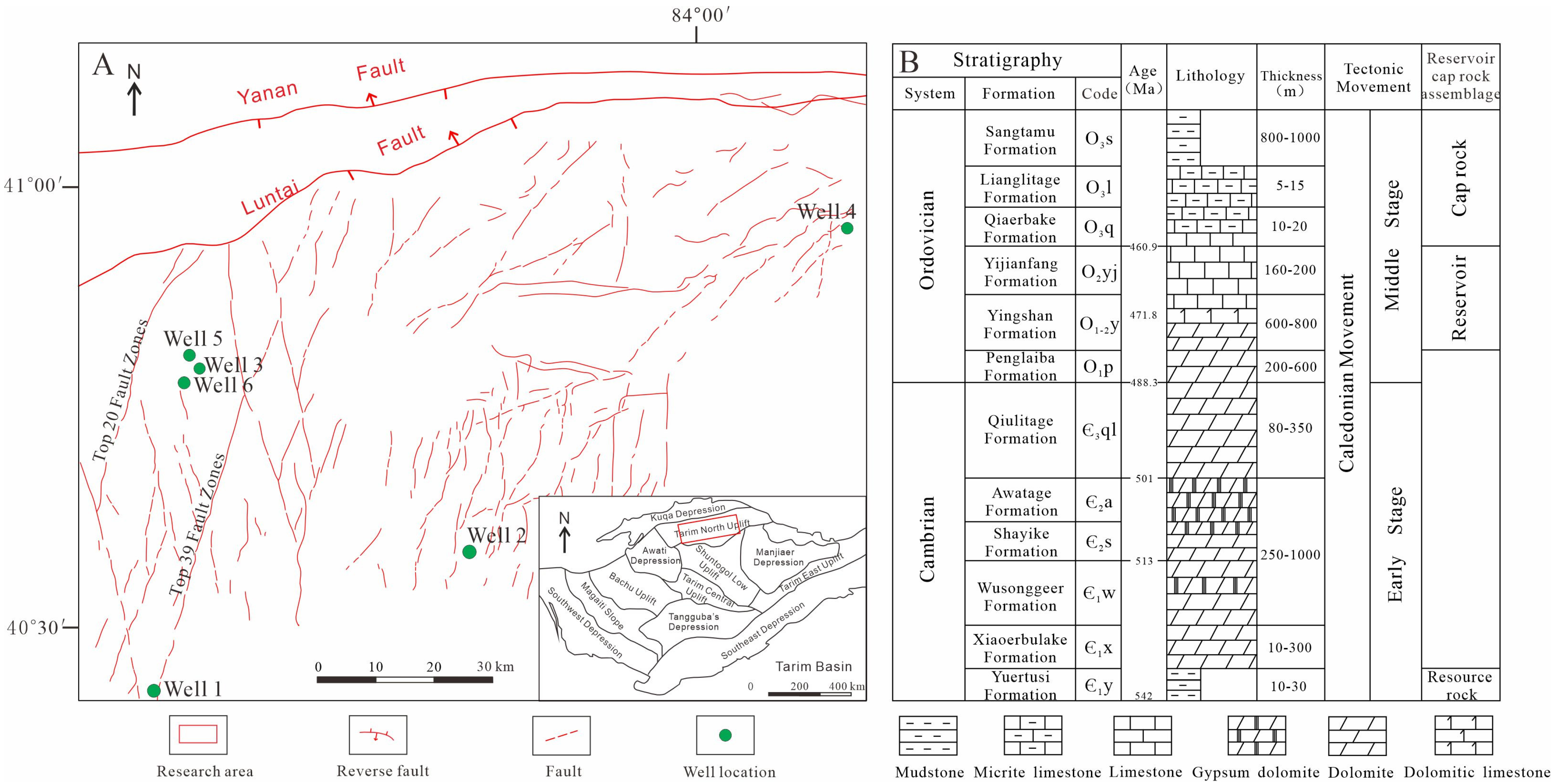
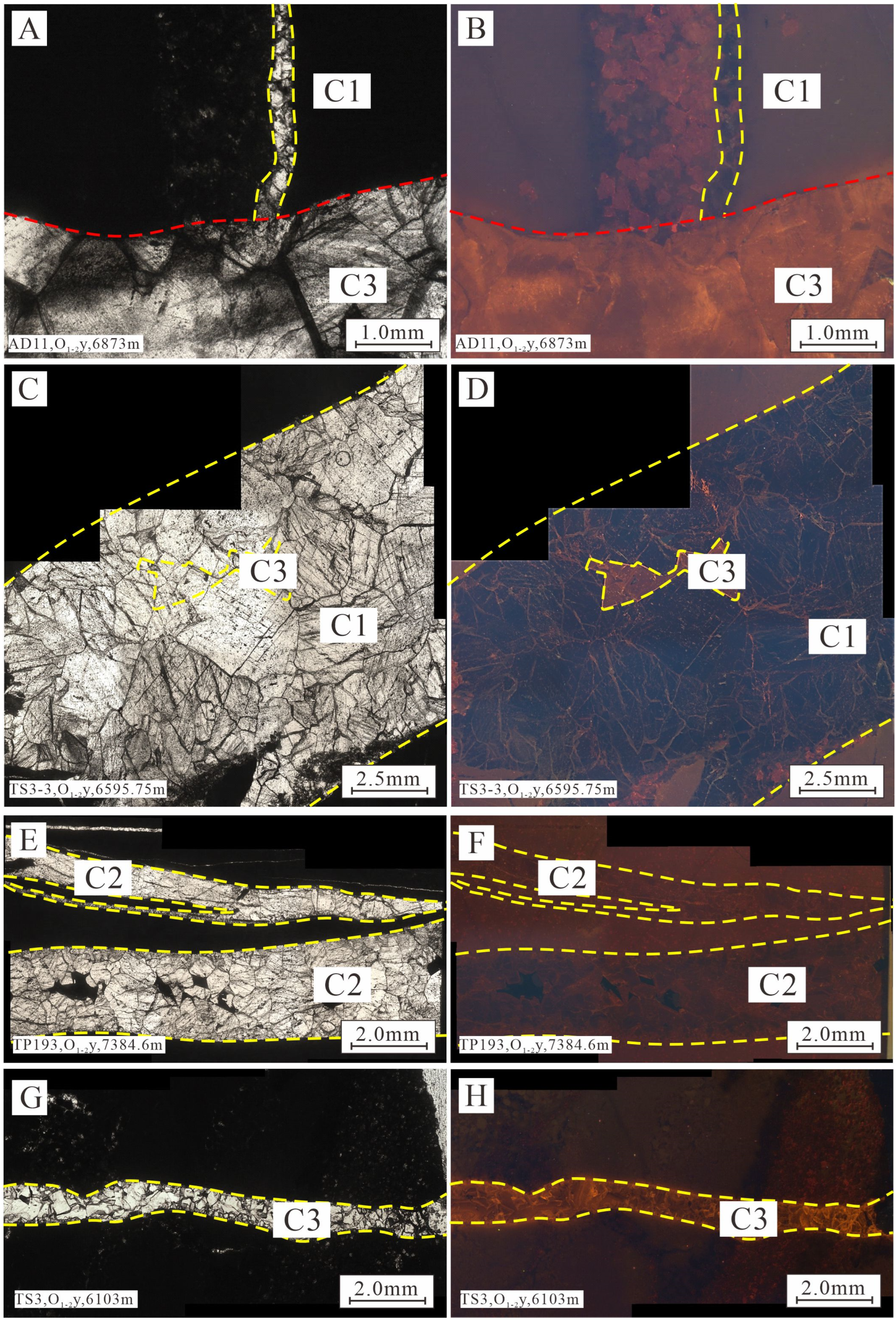

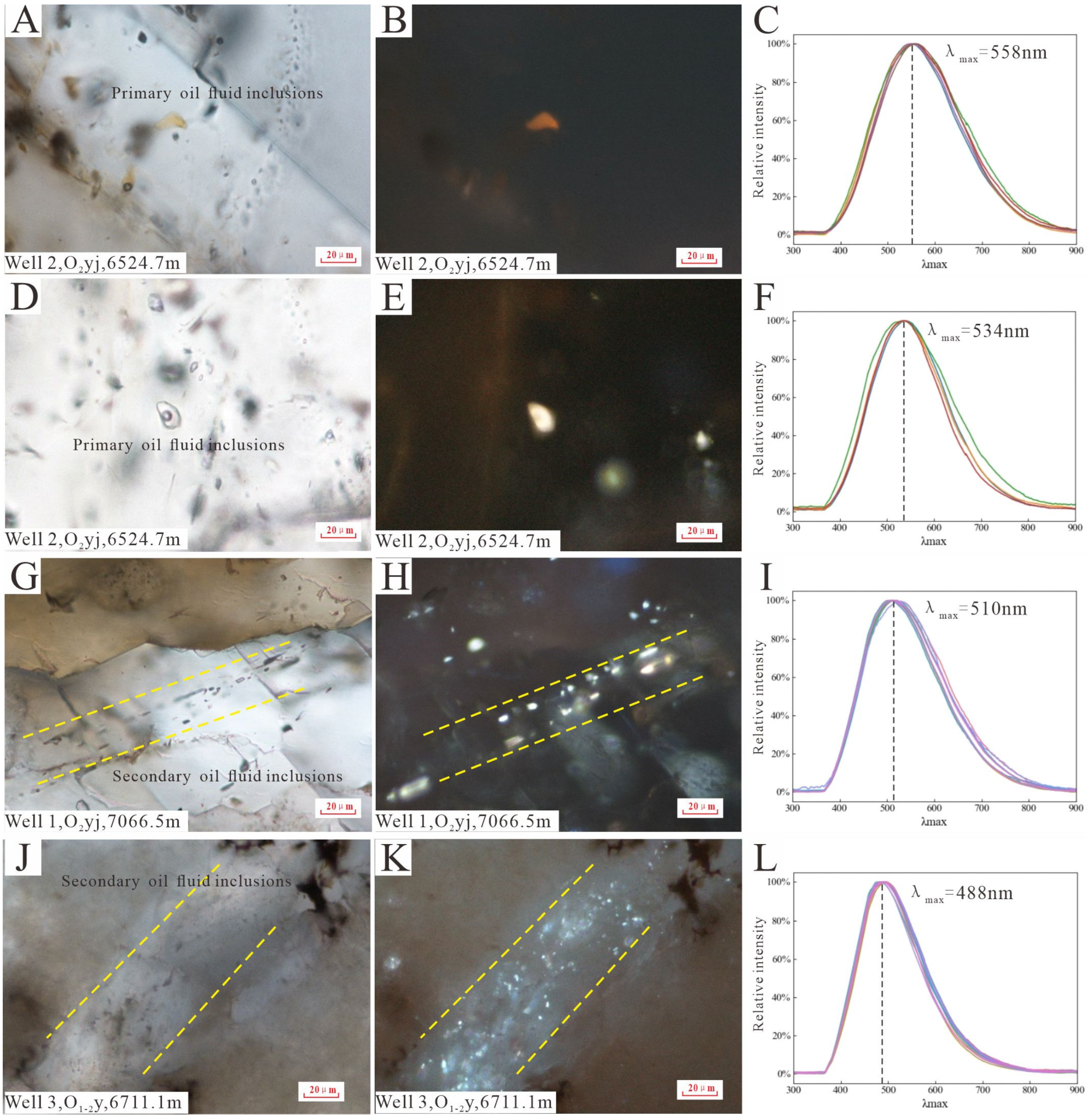
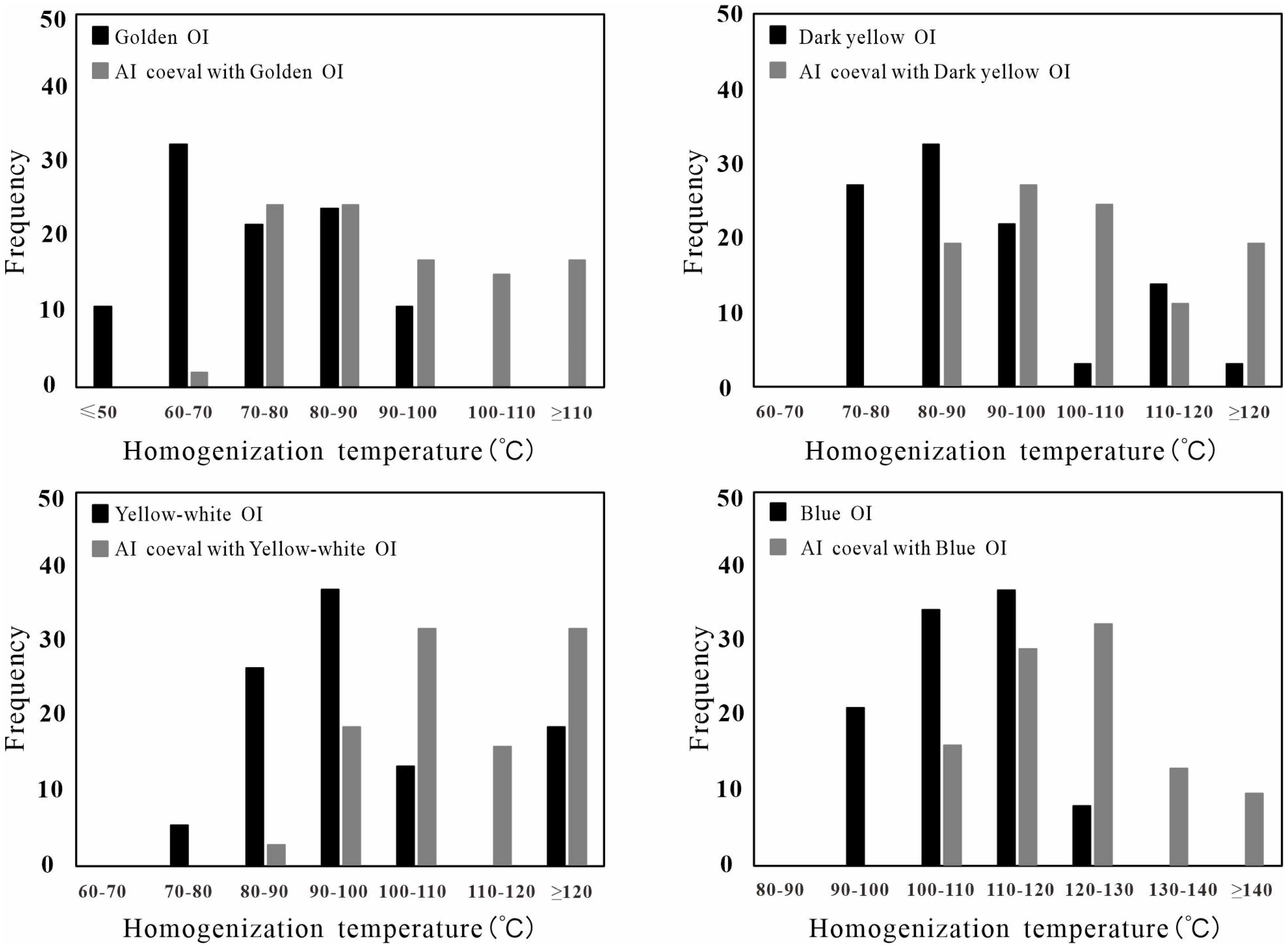
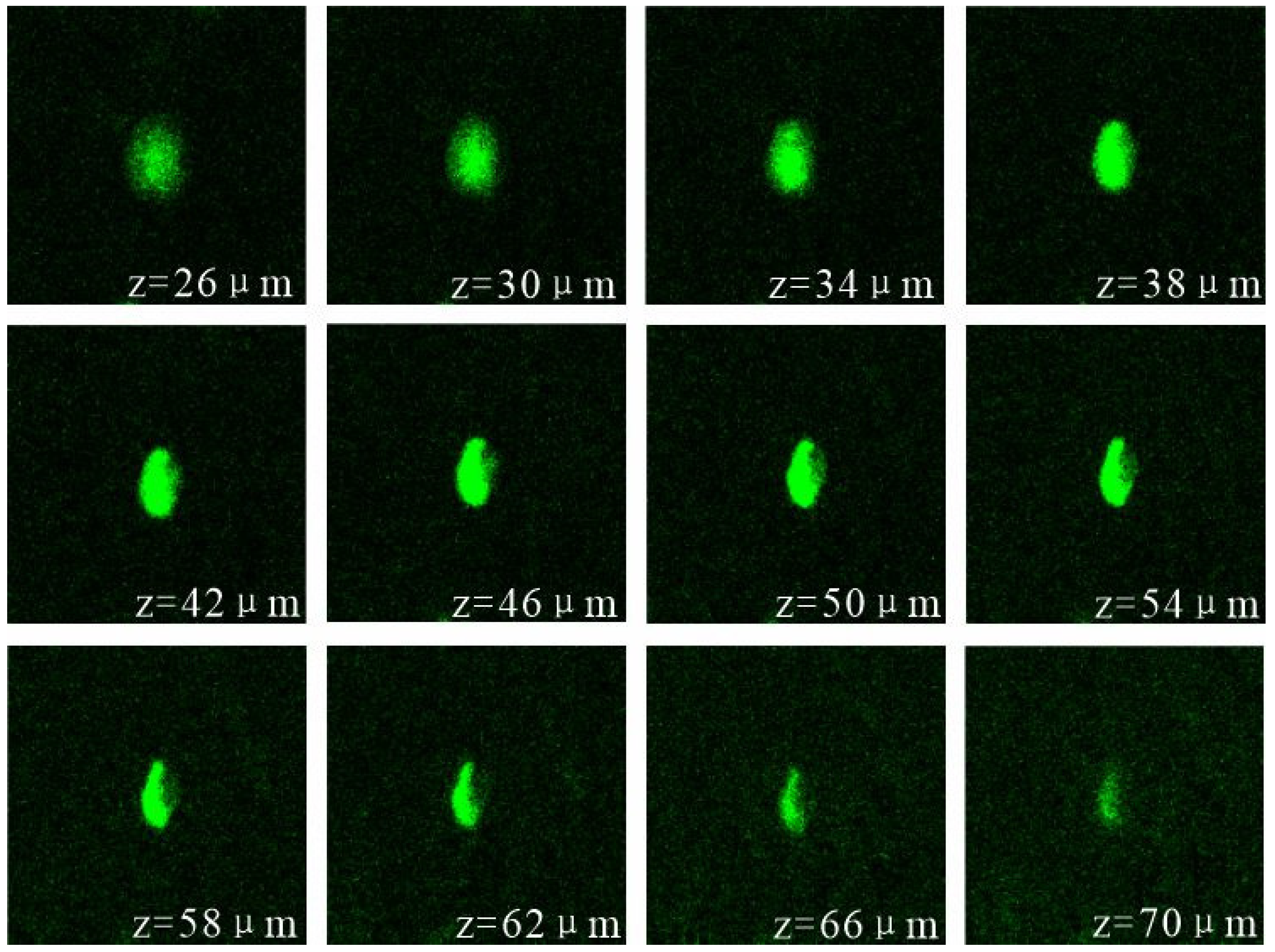


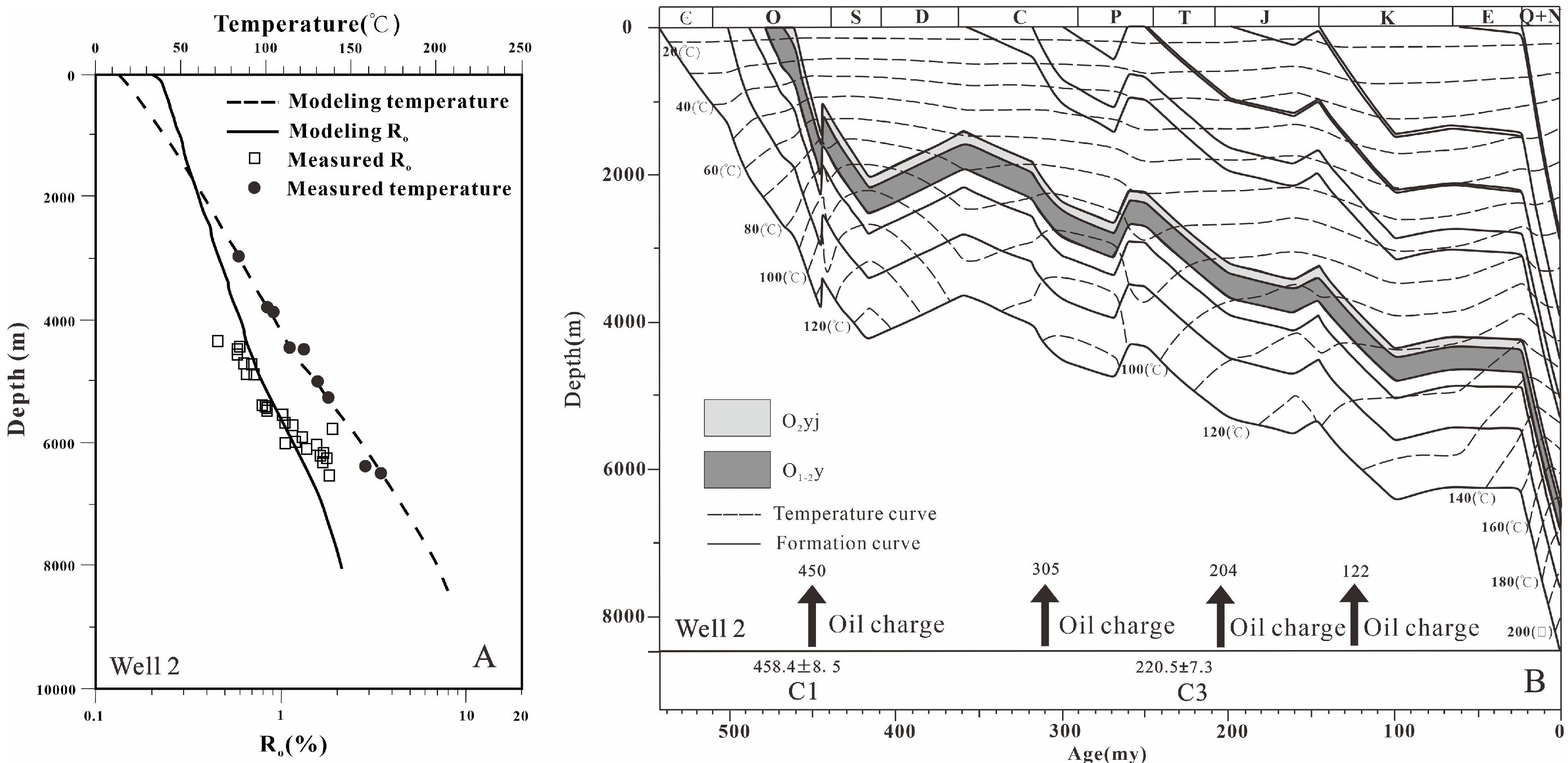

| Sample No. | Well | Formation | Depth/m |
|---|---|---|---|
| S5 | Well 1 | O2yj | 7066.5 |
| S7 | Well 2 | O2yj | 6524.7 |
| S13 | Well 3 | O1–2y | 6711.1 |
| S14 | Well 4 | O1–2y | 6629 |
| S22 | Well 3 | O1–2y | 6873 |
| S24 | Well 5 | O1–2y | 6595.75 |
| S27 | Well 6 | O1–2y | 6583.1 |
Disclaimer/Publisher’s Note: The statements, opinions and data contained in all publications are solely those of the individual author(s) and contributor(s) and not of MDPI and/or the editor(s). MDPI and/or the editor(s) disclaim responsibility for any injury to people or property resulting from any ideas, methods, instructions or products referred to in the content. |
© 2024 by the authors. Licensee MDPI, Basel, Switzerland. This article is an open access article distributed under the terms and conditions of the Creative Commons Attribution (CC BY) license (https://creativecommons.org/licenses/by/4.0/).
Share and Cite
Jiang, X.; Guo, X.; Zhu, Y.; Luo, T.; Chen, J.; Xu, H.; Zhao, X. Hydrocarbon Accumulation and Overpressure Evolution of the Ordovician Carbonate Reservoirs in the Tahe Area, Tarim Basin, NW China. Minerals 2024, 14, 1250. https://doi.org/10.3390/min14121250
Jiang X, Guo X, Zhu Y, Luo T, Chen J, Xu H, Zhao X. Hydrocarbon Accumulation and Overpressure Evolution of the Ordovician Carbonate Reservoirs in the Tahe Area, Tarim Basin, NW China. Minerals. 2024; 14(12):1250. https://doi.org/10.3390/min14121250
Chicago/Turabian StyleJiang, Xinyi, Xiaowen Guo, Yingzhong Zhu, Tao Luo, Junlin Chen, Hao Xu, and Xiaolin Zhao. 2024. "Hydrocarbon Accumulation and Overpressure Evolution of the Ordovician Carbonate Reservoirs in the Tahe Area, Tarim Basin, NW China" Minerals 14, no. 12: 1250. https://doi.org/10.3390/min14121250
APA StyleJiang, X., Guo, X., Zhu, Y., Luo, T., Chen, J., Xu, H., & Zhao, X. (2024). Hydrocarbon Accumulation and Overpressure Evolution of the Ordovician Carbonate Reservoirs in the Tahe Area, Tarim Basin, NW China. Minerals, 14(12), 1250. https://doi.org/10.3390/min14121250






